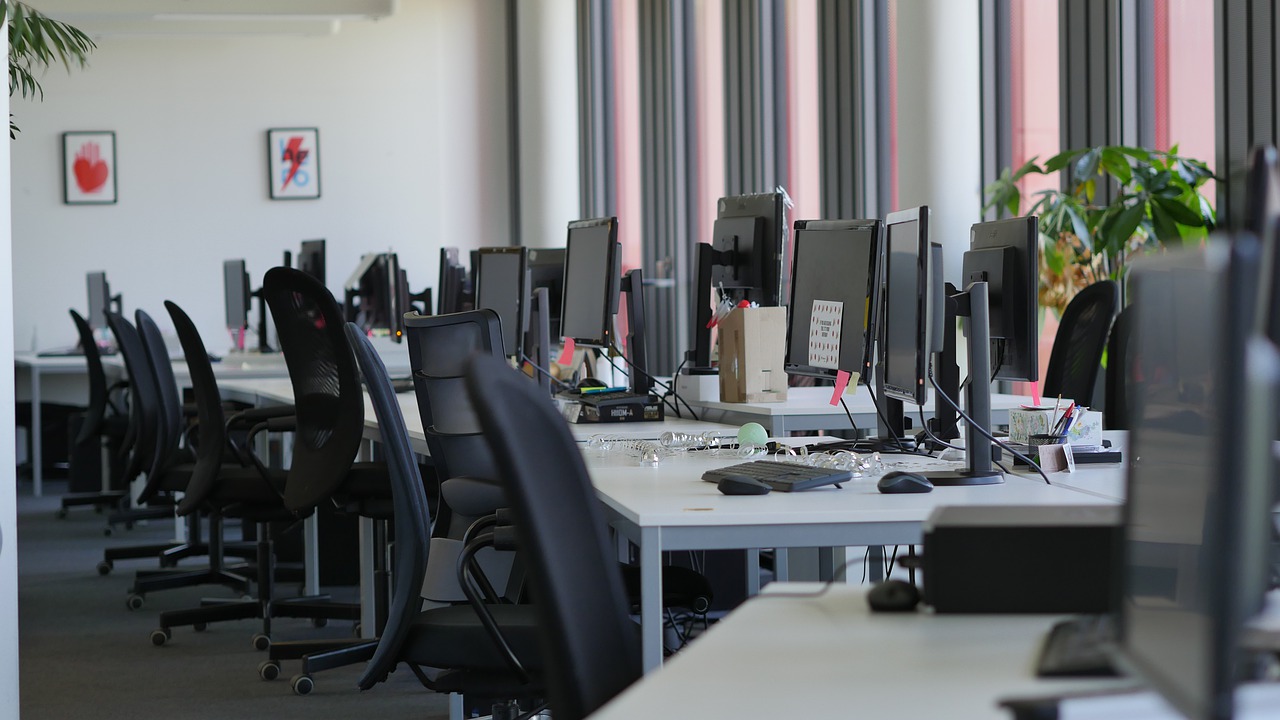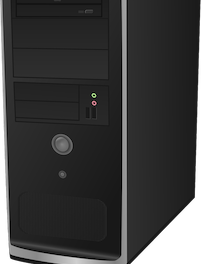
Challenges in the transition to desk sharing in the office
What needs to be considered when creating desk pools? Before introducing a software solution, the following fundamental questions must be clarified. The clarification can of course be done parallel to a test or pilot phase. We are flexible with our “Hot Desking” solution and are happy to support pilot projects.
Desk Pool Size
How large should the new workplace pool actually be? Which desks should remain permanently assigned? Which departments, which hierarchy levels, which roles are included/excluded? Should one of the open-plan offices be redesigned for this purpose? Many unknowns. It is ideal if companies can pilot the new model on a small scale and gain experience. Then it can be expanded incrementally.
Other companies, however, have very different circumstances. They’ve seen largely empty offices for months in the pandemic and feel the crushing weight of those fixed costs. Employees also seem happier in the home office. Thus, these firms are already on the lookout for a smaller office or they are looking to reduce or sublease portions of the office space. These companies need to choose the right office size from the beginning. This brings us to the question of the right “shared desk” ratio. This is very difficult to answer in a generalized way. It depends on many factors such as industry, country, representation (internal and external), cost pressure, as well as the “degree of digitization” for the home office (accessibility of all documents from the home office). For example, if employees have to come in more frequently because some documents are only available on paper on site).
-

- Layout of Open Plan Office
The long-term strategy regarding home office arrangements is also crucial. After all, there are guidelines such as “1-2 days per week we would like to see you in the office”. Many companies have already drawn up location-independent employment contracts with corresponding attendance rules in 2020. They contain specifications about on-site days per week or per month. They are part of the math.
The correct “shared desk” ratio can best be derived from the past months. Here, it may be possible to statistically process data from time recording. How many employees were there on average during the lockdown months? How was it during the summer months? It makes more sense to align yourself with the summer months if you want to have a reserve. Often the classic approach is “everyone who wants to come, we have to accommodate.” However, this does not have to be the top priority. Experience shows that if there are always enough places available, there is a compression on certain days of the week that are attractive to workers. For the rest of the week, the space is clearly oversized.
But if the office desks are often fully booked and waiting lists are in use, the situation is different. Here, many employees would switch to less heavily booked days of the week. Meanwhile, companies are also looking for ways to lure employees out of the home office with promotion days. These include pizza days or breakfasts with catering at the company’s expense. In this way, a higher attendance rate could be achieved on a statistically unpopular day of the week. If there is a permanent shortage on all days of the week, the “office refusers” will use this as an excuse not to come at all.
Here’s an example calculation: Suppose you had 100 permanent desks prior to the pandemic, all of which are now to be transferred to the desk sharing model or desk hoteling operation for reservation. Even before Corona, there were vacant desks due to vacation, sickness, business travel, and flexible working models. Typical vacancy levels in Germany are %5 due to illness and 10% due to vacation (concentrated on school vacations for families with school age children). There may also have been additional arrangements for one day of home office per week. Activities that require many assignments outside the office can also be deducted accordingly from empirical values. Roughly, a reduction to 60-65 places without risking conflicts seems possible. Below 50, you already risk booking conflicts on popular days. With a table offer of 30, seats become really scarce as soon as the “winter lockdown” is over. Your policies regarding home office may change, too. In this simplified example, we assume that all activities can be performed on the laptop without being present in the office.
Disclaimer: all organizations need to do their own math properly. It is impossible to derive the right formula for all cases. After all, there are super-optimistic growth plans or drastic saving plans that we don’t know about. But if you rent into a larger building, you can quickly scale up again. Or give the termination notice to the subtenant (see above for examples). Maybe that’s the best tip to prepare for unforeseen developments: negotiate shorter notice periods and select premises with expansion possibilities.
-

- Desk Sharing in Open Plan Office
Table arrangement
Open-plan offices are best suited for the desk-sharing model. Finally, you want to take advantage of other benefits of this office space concept. These include dynamic seating structures that reflect communication paths from current projects and workflows. As an example, this week a cross-departmen team of 4 people from project management, HR and quality need to prepare for a customer audit. They should be able to book neighboring desks so that they can also sit together.
In addition, “mixing” is desired. Through the random proximity to unknown colleagues, networking in the company is promoted in a natural way. This creates synergies and creates a positive atmosphere. Humans are creatures of habits. If the occupancy rate is low, employees will very quickly find themselves sitting at the same desks where they were assigned before the changeover. Therefore, it is worthwhile to consciously change the old layout – even if there is no shortage of space. The new layout should take into account the “corona distancing” between seats, as well as the space between people sitting and people passing by. Densification is quickly perceived negatively and will dampen the mood.
It makes sense to set up quiet zones for activities for concentrated work (e.g. programming) as well as separate zones for frequent callers (e.g. sales). See also our general blog post on the topic of hot desking.
Telephone system
It won’t work without forwarding to the cell phone. However, this is also the standard for home offices. Thus, most employees in the office are equipped with a “business cell phone”. If they have not yet been equipped with cell phones, the costs are manageable. Since more and more mobile phone tariffs offer national telephony at “flat” rates, the willingness to use private cell phones should also be higher. It becomes problematic with international telephony. In this case, there is no getting around the need to introduce company cell phones. This is needed in the home office scenario anyway.
-

- Telephone System in Office
It is conceivable to leave the “old” corded landline phones on the tables. In this way, frequent callers can book the table with their familiar “landline phone”. Provided the occupancy is not too high, this will work well. Another option would be to line up the phones on a sideboard in the open-plan office. This works especially well with the wireless landline models. That way, employees can quickly find their phone with a name tag, take it out of the charging cradle and have it at the booked desk for the day. Deactivate call forwarding and you’re done.
Special PCs or work equipment
Do you have certain profiles that can only work on certain PCs? For example, the CAD software licenses of the technical draftsman are non-floating (tied to one PC). Here you can choose permanent allocation or create a separate desk pool for the respective groups. This can be controlled in our solution via the layout. In general, you are more flexible with “floating” licenses. Maybe it’s no big deal for your IT to switch to floating licenses. Also notebooks, which are necessary for the home office anyway, give more degrees of freedom.
-


-
-
- PC Multifunction Printer
-
-
If there is special work equipment such as connected measuring devices, scanners, these can be specified via the workstation description in the booking software. Employees can take this information into account in their bookings.
The “personal” cabinet contents, pedestals, etc.
The cabinets can still be placed on the side walls or in separate rooms. Everything that needs to go to the table can be brought there in a basket, individually configured with office supplies. These baskets can be taken out of the cabinet or shelves/sideboards at the beginning of the day. If more material is needed at the booked place, there are various products such as mobile cabinets or so-called office caddies/trolleys. These can be used as flexible storage to meet a wide range of requirements.
-


- Office Supplies Overhead Cabinets or Roll Containers
Communication about Desk Sharing
We recommend transparency. Explain the advantages and what you expect from the new model for flexible desk bookings. After all, a large, empty office without the familiar faces does not boost the mood. Many colleagues are demoralized by empty office space at a time of pandemic.
-


- Advantages of Flexible Desk Booking Empty Office Space
Explain that the measure is intended to increase the quality of working days on site in the office and improve the atmosphere. Especially when the office space is drastically reduced, employees get worried. The “old, familiar” workspace is being moved to a desk pool. This could stir feelings like jobs are in jeopardy, too. Take these feelings serious and communicate proactively.
If you are cost-driven, better space utilization will free the company from unnecessary fixed costs. The money saved can be used for job security, growth and expansion of core competencies. Most employees should be able to follow this logic.
Some of our customers are companies that have grown in the pandemic. The new employees have not been assigned a desk at all. They have completed their probationary period in the home office. This is the simplest case and is certainly understood. In the short term, it is not considered wise to increase the office space. The vacancy rate in the office cannot be ignored. So the workplace pool must be introduced as the new home of the “new colleagues”. In order to avoid a two-class society feeling, “old colleagues” must also be included. This will also help the new colleagues to get used to the world of presence. This argumentation is reasonable and has good chances to foster acceptance.
If you’re fighting for a better atmosphere in the office and try to increase the attendance rate, then this is another case. Many will agree that one feels more comfortable in a well-attended office than in a larger office with lonely-looking isolated employees. Thus, controlled densification is necessary. If, contrary to guidelines such as “twice a week,” too few employees are on site, no one can insist that all regular seats remain. You can communicate this as a measure to lure colleagues out of the home office and promote the working atmosphere. This could be communicated as a temporary or permanent measure. Employees who see themselves in the home office for several days a week in the future should have few objections here.
Have we aroused your interest in the topic? Please contact us.
Read more: Hot desking: The eternally new workspace